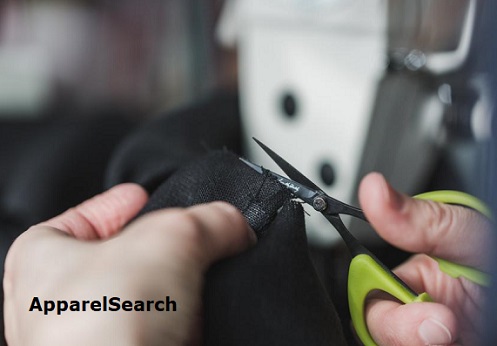 Askewed or Bias: condition where filling
yarns are not square with warp yarns on woven fabrics or where courses are
not square with wale lines on knits.
Askewed or Bias: condition where filling
yarns are not square with warp yarns on woven fabrics or where courses are
not square with wale lines on knits.
Back fabric Seam Impression: backing fabric is often used to cushion fabric being printed. If there is a joining seam in the backing fabric, an impression will result on printed fabric.
Barre: occurs in circular knit. Caused by mixing yarn on feed into machine. fabric will appear to have horizontal streaks.
Birdseye: caused by unintentional tucking from malfunctioning needle. Usually two small distorted stitches, side by side. This term should not be confused with birdseye fabric which is in fact created intentionally.
Bowing: Usually caused by finishing. Woven filling yarns lien in an arc across fabric width: in knits the course lines lie in an arc across width of goods. Critical on stripes or patterns and not as critical on solid color fabrics.
Broken Color Pattern: Usually caused by colored yarn out of place on frame.
Color Out: the result of color running low in reservoir on printing machine.
Color Smear: The result of color being smeared during printing.
Crease Mark: differs from crease streak in that streak will probably appear for an entire roll. Crease mark appears where creases are caused by fabric folds in the finishing process. On napped fabric, final pressing may not be able to restore fabric or original condition. Often discoloration is a problem.
Crease Streak: Occurs in tubular knits. Results from creased fabric passing through squeeze rollers in the dyeing process.
Drop Stitches: results from malfunctioning needle or jack. Will appear as holes or missing stitches.
Dye Streak In Printing: Results from a damaged doctor blade or a blade not cleaned properly. Usually a long streak until the operator notices the problem.
End Out: Occurs in Warp knit. Results from knitting machine continuing to run with missing end.
Hole: caused by broken needle.
Jerk-in: caused by an extra piece of filling yarn being jerked part way into the fabric by the shuttle. The defect will appear at the selvage.
Knots: caused by tying spools of yarn together.
Missing yarn: Occurs in warp knit. Reuslts from wrong fiber yarn (or wrong size yarn) placed on warp. fabric could appear as thick end or different color if fibers have different affinity for dye.
Mixed End (yarn): yarn of a different fiber blend used on the warp frame, resulting in a streak in the fabric.
Mottled: Color applied unevenly during printing.
Needle Line: Caused by bent needle forming distorted stitches. Usually a vertical line.
Open Reed: results from a bent reed wire causing warp ends to be held apart, exposing the filling yarn. Will be conspicuous on fabrics that use different colored yarns on warp and shuttle.
Pin Holes: Holes along selvage caused by pins holding fabric while it processes through tenter frame.
Press-Off: results when all or some
of the needles on circular knitting fail to function and fabric either falls
off the machine or design is completely disrupted or destroyed. Many
knitting needles are broken and have to be replaced when bad press-off occurs.
Bad press-offs usually start a new roll of fabric.
Printing Machine Stop: Dye or ink smudged along width of fabric as a result of the printing machine stopping.
Print Out of Repair: Caused by print
rollers not being synchronized properly. This results in various colors
of the design not being printed in the proper position.
Puckered Selvage: Usually caused by selvage being stretched in finishing or by uneven wetting out in sanforization process.
Runner: caused by broken needle. The runner will appear as vertical line. Most machines have a stopping device to stop the machine when a needle breaks.
Sanforize Pucker: Results from uneven wetting out on sanforize; usually caused by defective spray heads. fabric will appear wavy or puckering when spread on cutting table. Difficult to detect while inspecting on inspection machine with fabric under roller tension.
Scrimp: the result of fabric being folded or creased when passing through tenter frames.
Slub (woven fabric): usually caused by an extra piece of yarn that is woven into fabric. It can also be caused by thick places in the yarn. Often is caused by fly waste being spun in yarn in the spinning process.
Slub (Knit fabric): Usually caused by a thick or heavy place in yarn, or by ling getting onto yarn feeds.
Smash: caused by a number of ruptured warp ends that have been repaired.
Soiled Filling or End: Dirty, oily looking spots on the warp or filling yarns, or on packaged-dyed yarn.
Stop Mark: when the loom is stopped, the yarn elongates under tension; when the loom starts again, the slack is woven into the fabric.
Straying End: Warp Knit. Caused when an end of yarn breaks and the loose end strays and is knit irregularly into another area.
Thin Place: often caused by the filling yarn breaking and the loom continuing to run until the operator notices the problem.
Water Spots: Usually caused by wet fabric being allowed to remain too long before drying: color migrates leaving blotchy spots.
Yes, there are more fabric defect terms in existence. However, this is the best list we have for you at the moment. If you know additional terms, or updates to the terms listed above, please do not hesitate to let us know. We would be happy to add your suggestions. The goal is to help educate. If you have more information on this subject, please share your knowledge with us.
Learn about shade lots & color variances for yarn, fabric, and clothing.
Learn more about fabrics and the fashion industry at the Fashion Industry Network.
Find fabric mills around the world.
Thank you for using the Apparel Search website.
Read up on the latest textile industry news.
